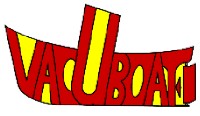|
|
|
Detailing a towboat... What all is on there? REMEMBER (click on photos for larger images) What all do you find on a towboat? Here's a list to go by to have every thing that the real boat has. We know from the boat we're modeling how many stacks, tow knees, and winches the boat has. Let's start from there and make a check list of items in general to check off. Some boats will have a couple of one item while others will have several, so it's good to have photos to detail by. I'm going to concentrate the list mere to the trip and line haul boats since the small harbor boats are usually sparse. A capstan or two on the bow deck. possibly a hand deck winch on the stern. At least 4 life rings Air intake for each engine and auxiliary generator. Exhaust pipe for each engine and auxiliary generator. 2 flood lights on 3rd deck facing forward, 2 floods on 3rd deck 1 port & 1 stbd, 2 floods stern 1 port & 1 stbd Minimum 2 fire stations on main cabin 1 port, 1 stbd. HALO fire stations next to engine room doors port & stbd. 1 or 2 yawls with yawl crane for each. Gasoline tank for outboard motor fuel storage. Horn light (orange), anchor lights (one at front of roof and one on pole on rear of roof), Port (red) & stbd (green) navigation lights on roof Minimum 2 spot lights and a loud speaker on front of roof. 2 trumpet or 4 trumpet horn ( some boats may have 3 or 5 trumpets). 2 radars, 2 VHF antennas, 1 UHF antenna, antennas for cell, satellite, TV, etc. Guard lights on cabins to light walkways. fire alarm lights (red) next to engine room doors port & stbd. Galley exhaust vent (sometimes same vent used for electronics room), Toilet exhaust vents Engine room exhaust vents (sometimes on deck, sometimes in stacks) A ladder used to climb from loaded barges to empty barges. Fuel hoses hanging on racks on hand railing or stern. Pennant flags on tow knees.
Aux. generator intakes and exhausts
Finished items can be viewed on the G. L. Furr page.
Galley exhaust
Grid deck
Capstan
"H" bitt
Ratchet
Tow lights
Yawl
Finished item can be viewed on the G. L. Furr page.
Tow knees Photos were taken aboard m/v G L FURR. Original paint (red) in April 2005 and new paint (gray) in Oct. 2005. I made the main body of the tow knee from thick sign stock. You know, those big ole FOR RENT and FOR SALE BY OWNER signs. Have you ever seen a FOR RENT BY RENTER? or FOR SALE BY THIEF? dumb signs!!! Anyway I have a better use for them. They're the same styrene that you pay big bucks for at hobby shops. All you have to do is sand the paint off before gluing. The steps are Plastruct as is the modified hand railing. Finished item can be viewed on the G. L. Furr page.
Deck Winch used on barges and a drawing for making your own
Common winch used on towboats Scratch building a winch (easy technique) I used some small spools found at a crafts store, styrene, 1/8" basswood, 3/16" dowel rod, 1/8" dowel rod axle peg mentioned above and a couple of gears taken from old broken toys, clocks, tape player, etc. I used the dowel rod for the winch pump and the axle peg for winch motor. You can add more detailing by adding grooves in the axle peg as cooling fins and use some small brass or plastic rod for the cross bracing.
More details found on deck
I've found a simple way of scratch building an axe. I use a piece of strip styrene slightly narrower than 1/8" and cut an angle on one end. The other end I rough cut to match the photo and used an emery board to round off the edge and taper it down to a point. You only need to round it down and cut the edge on one side since the other side will be glued to the cabin. I used a smaller piece of styrene for the handle and used the emery board to round off the edges a little. Then I used tweezers to pinch a little curve on the end. For 1:48 scale I think it turned out pretty good. For more detailing you can paint the brass brackets on the axe and even fashion the cutting end into the bracket itself.
I then used nylon screen door screen for the bottom grid work. Then I used .100" plastic angle 12 scale inches long for support legs. After that came plastic rod cut 24 scale inches. Rigging racks are usually painted the same color as the deck, but it's your option what color you want yours to be. Now all we need to do is make some coils of rigging to put on them.
Those pennant flags you see on the tow knees are there for a purpose. The pilot uses them to tell the direction and strength of the wind. Wind is rough with empty barges.
|









































 I've looked everywhere to find fire axes for my
boats. Bluejacket Shipcrafters used to have them, but was discontinued.
I've looked everywhere to find fire axes for my
boats. Bluejacket Shipcrafters used to have them, but was discontinued.

 Above shows how I made simple rigging racks. I
used strip styrene .040" x .060" to make a 4 scale foot square.
Above shows how I made simple rigging racks. I
used strip styrene .040" x .060" to make a 4 scale foot square.













 TM
TM